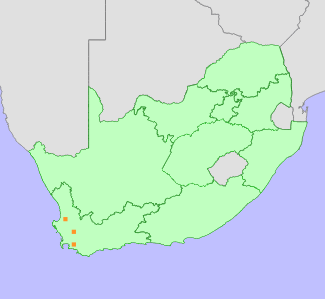|
Scientific Name | Sparaxis grandiflora (D.Delaroche) Ker Gawl. |
Higher Classification | Monocotyledons |
Family | IRIDACEAE |
Common Names | Botterblom (a) |
National Status |
Status and Criteria | Near Threatened B2ab(i,ii,iii,iv,v) |
Assessment Date | 2023/05/23 |
Assessor(s) | N.N. Mhlongo, N.A. Helme, L. von Staden, P. Goldblatt, D. Raimondo, I. Ebrahim & T. Patel |
Justification | This formerly widespread species has an extent of occurrence (EOO) of 21 265 km² and an area of occupancy (AOO) of 508 km². It occurs in more than 30 locations however, some of the subpopulations are small and isolated. The population continues to decline due to habitat loss and competition from alien invasive plants. With the population declining and severely fragmented, but with more than 10 locations extant it almost reaches the thresholds for listing as Vulnerable under criterion B and is assessed as Near Threatened. |
Distribution |
Endemism | South African endemic |
Provincial distribution | Western Cape |
Range | This species is widespread in the southwestern Western Cape, South Africa, stretching from Clanwilliam (and possibly Graafwater) in the northwest to Bredasdorp in the southeast. |
Habitat and Ecology |
Major system | Terrestrial |
Major habitats | Fynbos |
Description | It occurs at low elevations and mostly on heavy clay soils but can be sometimes found on sandy ground, often waterlogged in winter. |
Threats |
| At least 62% of this species' range has been irreversibly modified, primarily due to extensive agricultural expansions, including vineyards towards Tulbagh and citrus cultivation around the Olifants River Valley. Urban expansion in Clanwilliam, Citrusdal, and other towns has also contributed to this habitat loss. Much of the renosterveld habitat has been reduced to small fragments, most of which are degraded, and this loss continues. Additionally, this species is threatened by competition from spreading, unmanaged alien invasive plants. |
Population |
This species is locally common in its habitat. Citizen scientists have recorded 342 observations of this species on the iNaturalist platform between 2009 and 2023. However, the population has been extensively reduced due to habitat loss across its range, and the decline continues. Most of the subpopulations are small, isolated, and occur on severely degraded fragments. Additionally, certain subpopulations have gone extinct at sites known from historical records.
|
Population trend | Decreasing |
Bibliography |
Goldblatt, P. and Manning, J.C. 2000. Cape Plants: A conspectus of the Cape Flora of South Africa. Strelitzia 9. National Botanical Institute, Cape Town.
Goldblatt, P. and Manning, J.C. 2020. Iridaceae of southern Africa. Strelitzia 42. South African National Biodiversity Institute, Pretoria.
|
Citation |
| Mhlongo, N.N., Helme, N.A., von Staden, L., Goldblatt, P., Raimondo, D., Ebrahim, I. & Patel, T. 2023. Sparaxis grandiflora (D.Delaroche) Ker Gawl. National Assessment: Red List of South African Plants version 2024.1. Accessed on 2025/12/13 |
 Comment on this assessment
Comment on this assessment

